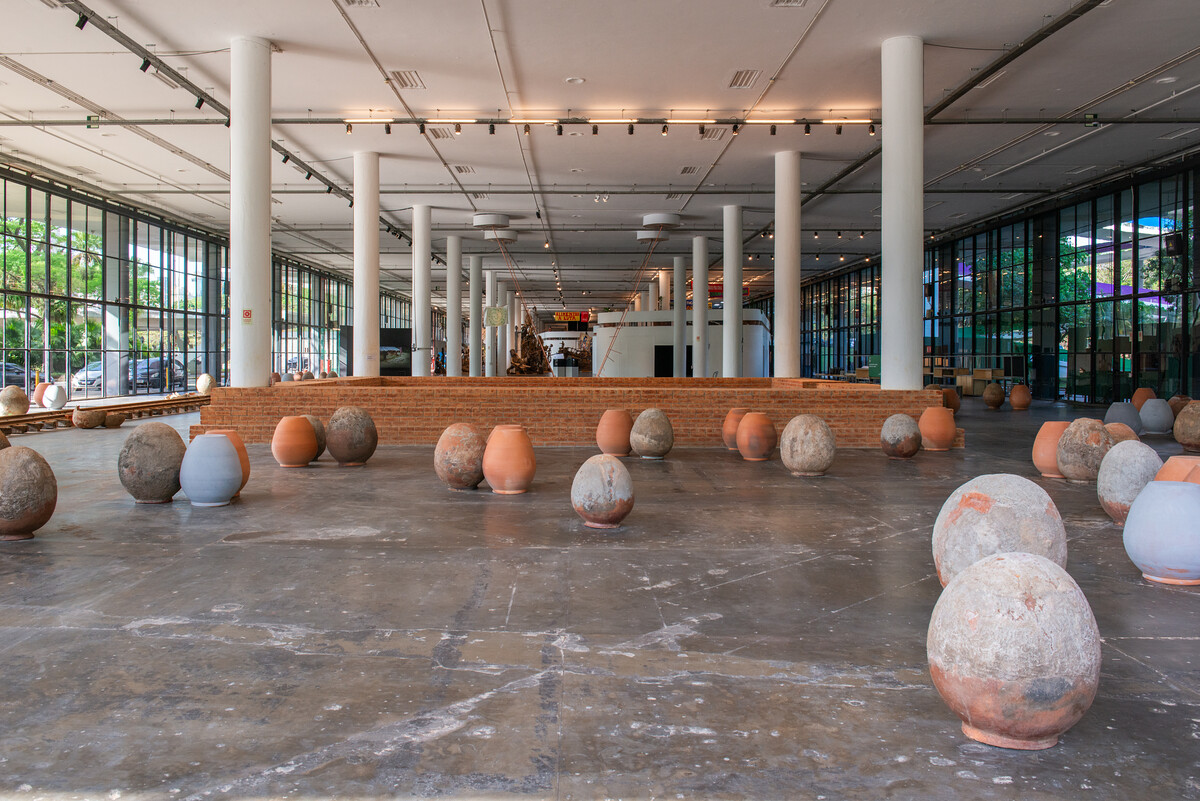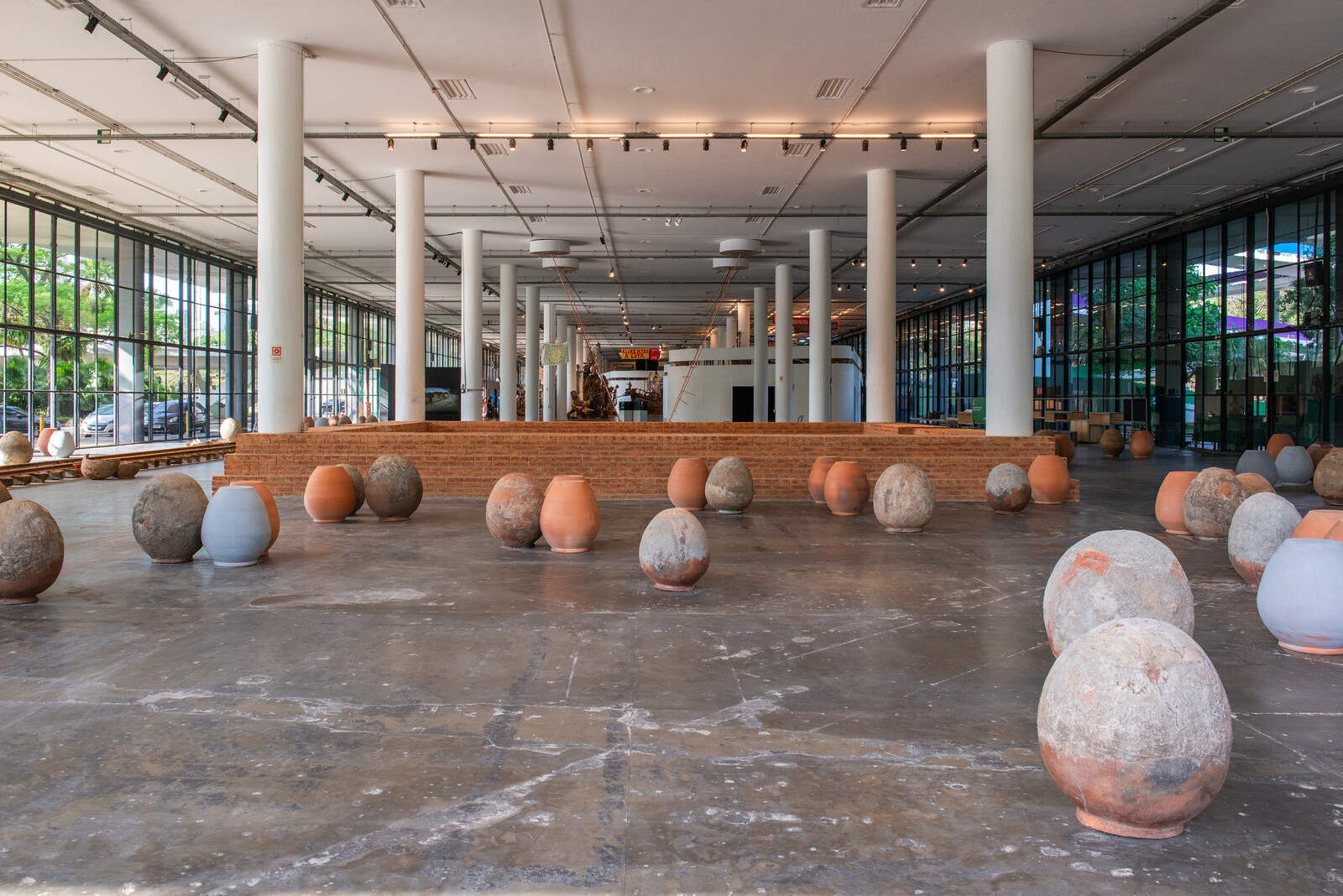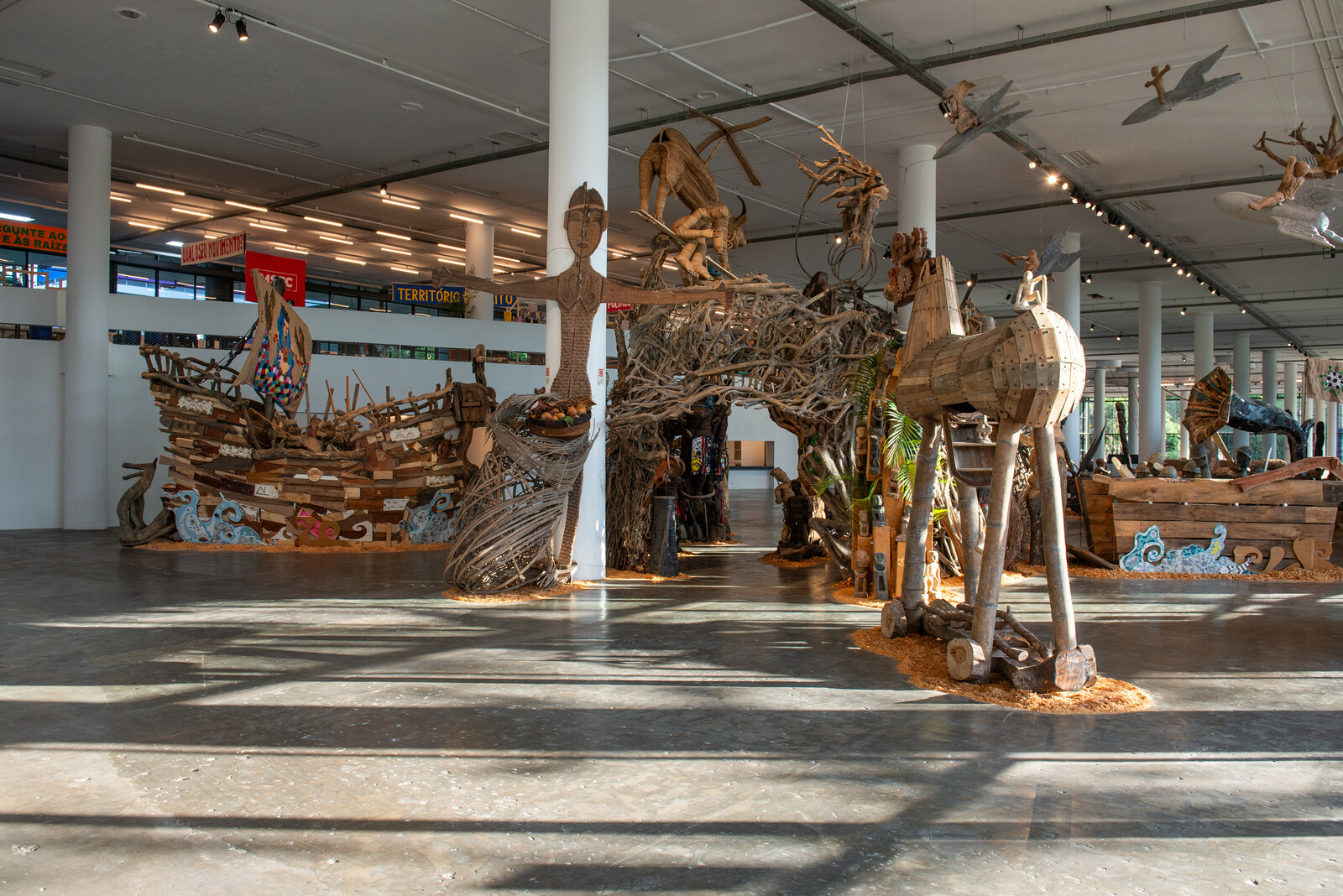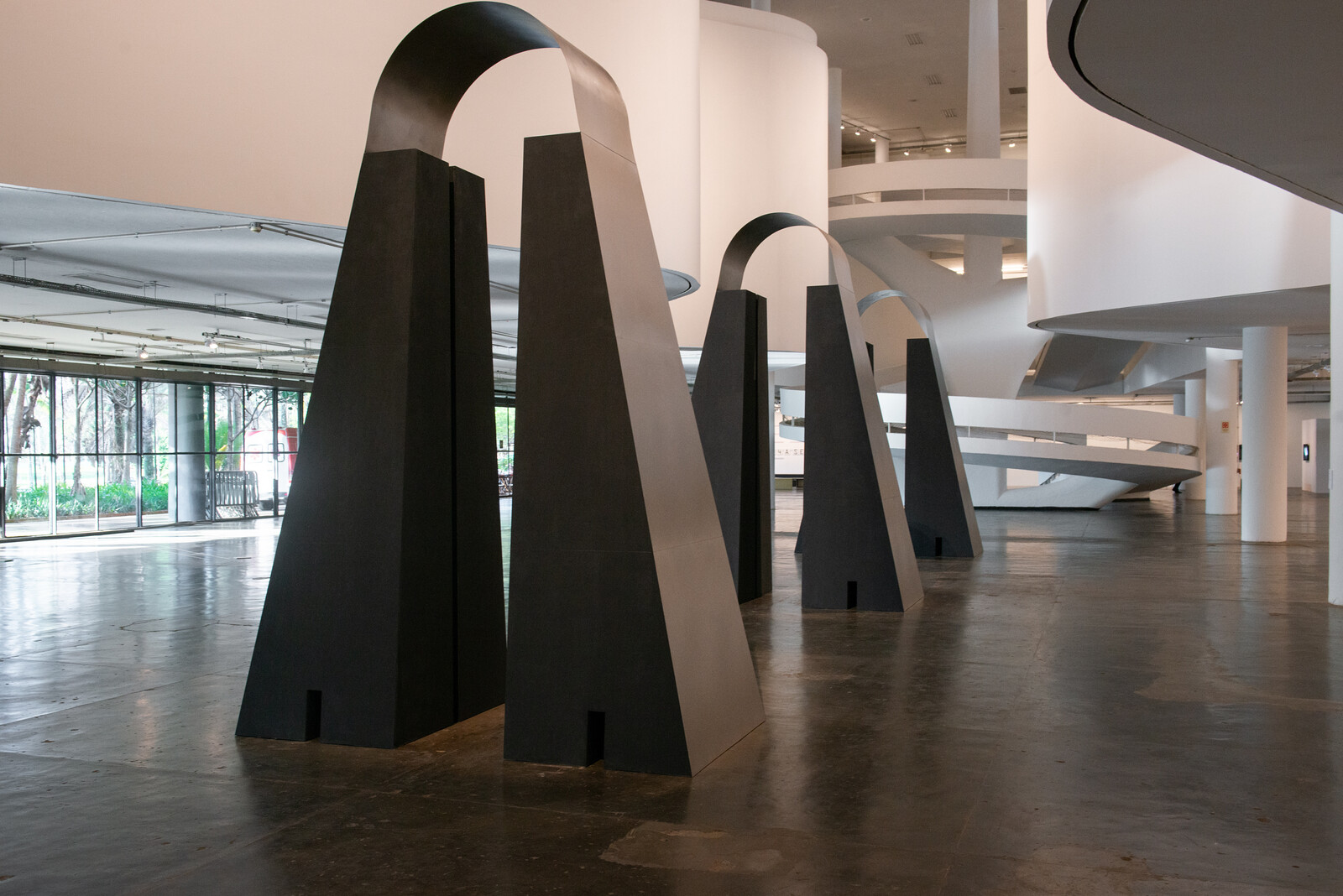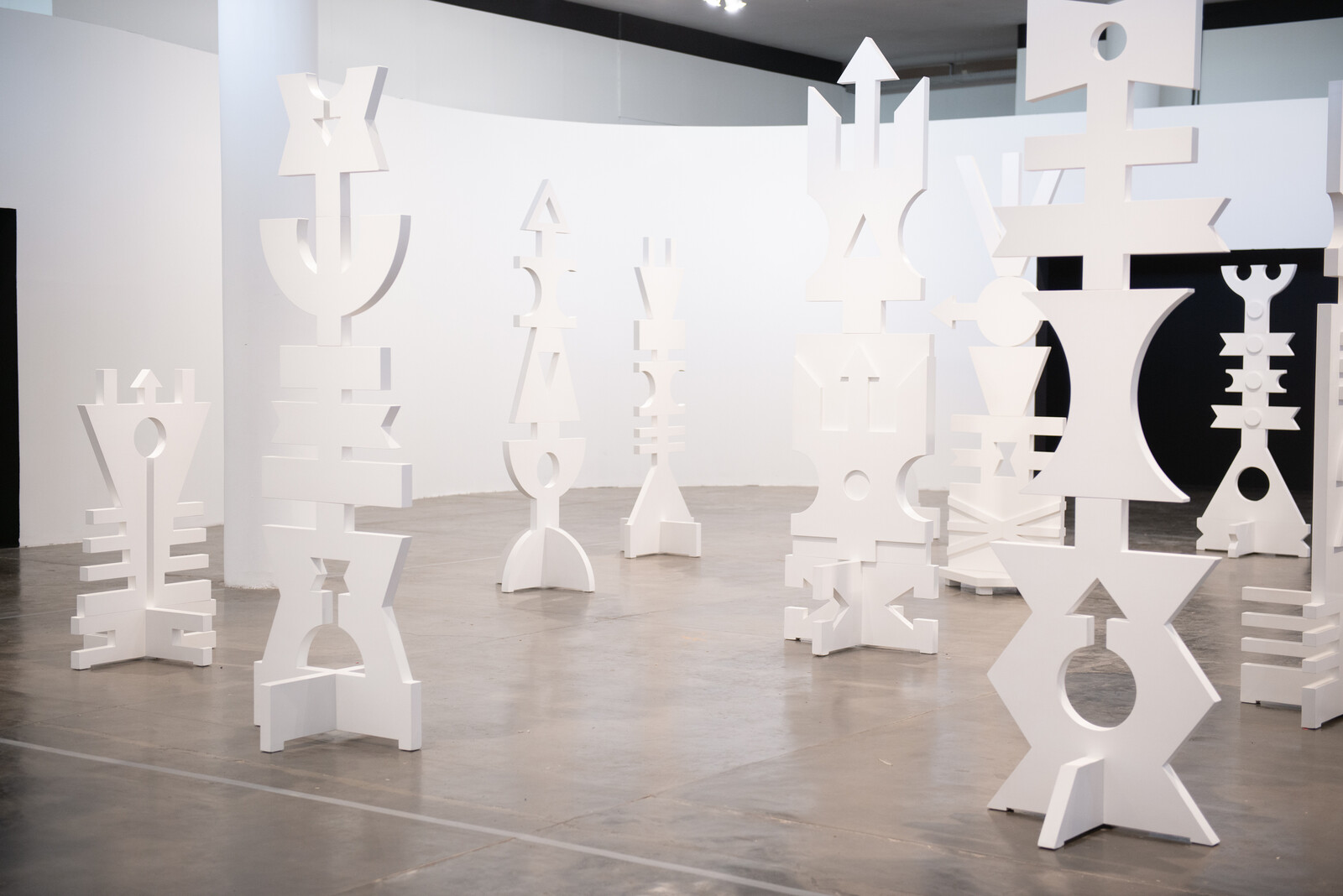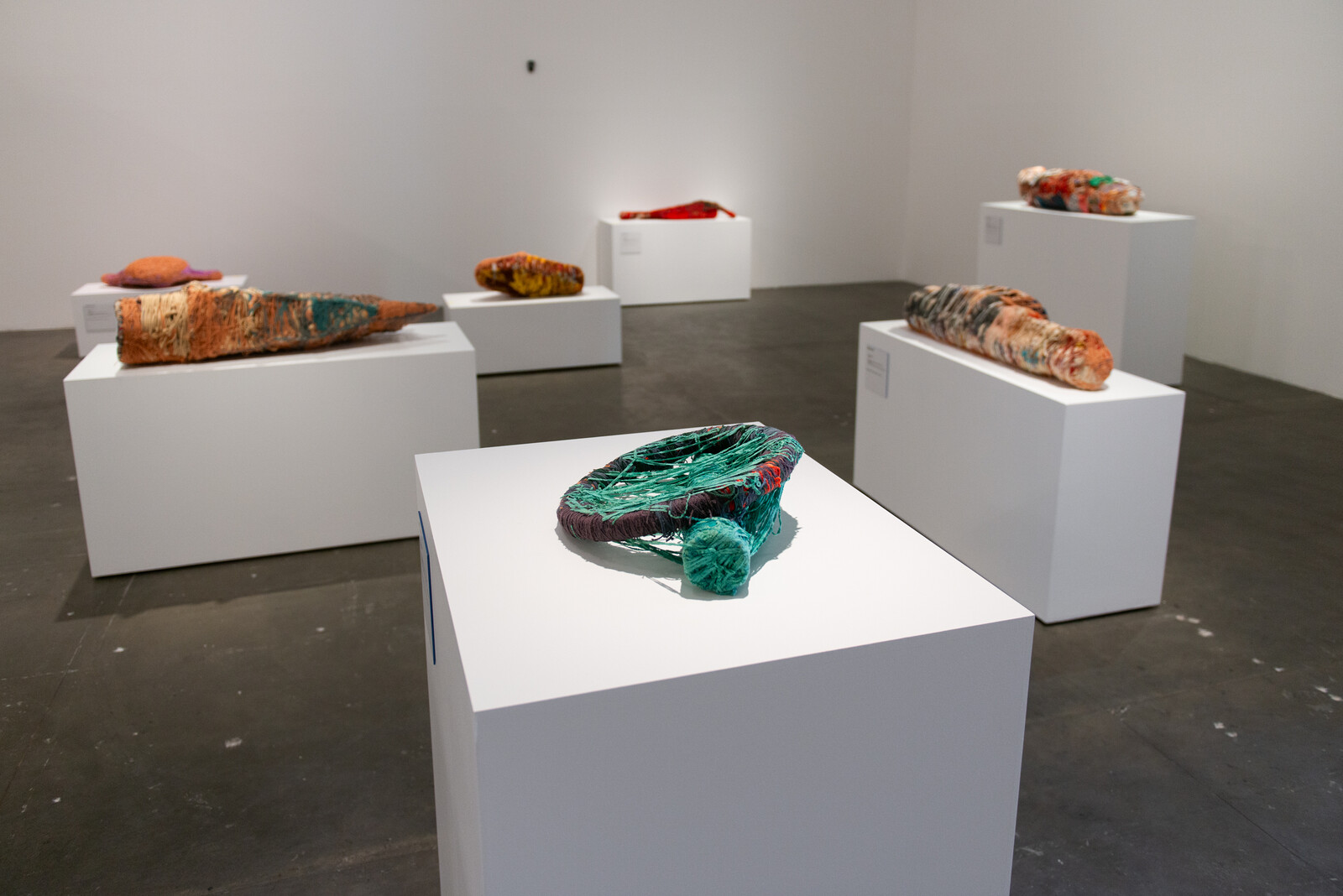September 6–December 10, 2023
The Oscar Niemeyer building that houses “choreographies of the impossible,” the 35th edition of the Global South’s oldest biennial, is as much protagonist as background. Located in the bustling urban park of Ibirapuera, the art inside this architectural leviathan is only separated from the city’s greenery by glass walls, and its entrances are open six days a week. There is no charge to enter, monetary or otherwise: visitors needn’t reserve, wait, or check in with personal data like email addresses or postal codes, but can glide in and out as if the show were an extension of public space. This allows for viewing at a leisurely pace—important, given that there’s no quick way to tour 270,000 square feet of impossible choreographies.
A short wall text jointly attributed to the curators (Diane Lima, Grada Kilomba, Hélio Menezes, and Manuel Borja-Villel) touches on the subversion of temporal structures in a selection of works “based on cosmologies and models of governance where time is conceived as a spiral, without the rigidity of established structures and chronologies”—although a spiral is a type of structure, too. Perhaps it would be more precise to say that the curators attempted to eschew linearity. While they have successfully executed this experiment, as a result, perhaps the sum of the exhibition’s parts isn’t quite as much as it might have been.
The curators add that “this Bienal has been staged without categories or themes.” It’s true there is little in the way of orienting didactics for the show: even the three floors of the building have had their numeric hierarchy recoded with colors: “green,” “blue,” and “purple.” But to claim it is themeless obfuscates the vital topic of colonial exploitation that is investigated explicitly and extensively in many if not most of the works by more than 100 artists—quite in a way that is ordinarily read as a curatorial theme.
To be clear, surely the curators know what their show is about. They make textual allusions in more lyrical prose and have assembled a kaleidoscope of artists working in postcolonial contexts around the world. But it’s a choice to elide any mention of its binding principle. It’s another choice not to disclose certain biographical information, like the fact that Judith Scott—who posthumously contributes a room of haunting sculptures of bunched fabrics wrapped in webs of yarn and displayed on plinths, many proportioned like miniature bodies—lived as a deaf woman with Down syndrome. This is a show mainly comprised of artists who belong to marginalized groups, and abstains from the vulgarity of indexing people along these lines except when contextually necessary. Instead the work speaks for itself, and on an individual basis this is admirable. Most arrows in the exhibition’s quiver are piercing, but the target towards which they are directed is not always clear.
Some of the most memorable works in the show are new commissions of monumental sculptural installations. In a wall label, the curators refer to Filipino artist and filmmaker Kidlat Tahimik’s approach to “sculpting as a cinematographic process,” and indeed there is an epic, episodic quality to the massive tableaux of primitive shelters and invading barges hewn from logs and driftwood and set upon piles of sawdust. Killing us Softly… with their SPAMS… (Songs, Prayers, Alphabets, Myths, Superheroes…) (2023) shows the entire colonial story, from missionaries to Marvel, frozen in wood. The scene is like a theme park itself, with plot twists visible from every angle. Its greeter is a hooded Mickey Mouse operating a film camera, from the lens of which projects a chainsaw blade.
A classic problem of biennials is exacerbated in São Paulo by the layout: the moving image works tucked around every corner loop in their own little realms as demanding footnotes to an already engrossing narrative. An exception is a trio of films on video monitors at the start of the show by Black American dancer and choreographer Katherine Dunham. Not only do these pieces, dated 1947–60, tether the exhibition to the era in which Brazil’s public modern art institutions were founded (MASP in 1947, the Bienal four years later), but they link to the story of how Dunham inspired the passing of a 1951 law effectively criminalizing racism.1
If this is one argument for choreography’s political potency, other literal examples of the exhibition’s titular motif of choreography come across as peripheral or tangential. In this context, the dances for camera by Renate Lorenz and Pauline Boudry—“about desire,” for instance, and shown in one of those tucked-away locations—feel silly and exceedingly low stakes, given that the show’s overarching plot is a history of how today’s world is the product of systemic violence and domination.
There’s an integrity to how this biennial situates diverse practices from postcolonial nations not as a congress—in which each work is supposed to represent its identitarian constituency—but as a chorus, in which vocals blend to bridge time and space. For example, in Tahimik’s work the figure of the devastated forest binds the Philippines to Brazil. There is a pattern of works echoing those by other artists: Sonia Gomes’s biomorphic sculptures toughly wound in various textiles, for example, are displayed just a few steps from Scott’s work.
Scattered across the building are three pieces featuring collections of ceramic vessels: the expanse of upturned pots in Ibrahim Mahama’s Parliament of Ghosts (2019); the forty-four broken urns and bowls that hold hardened cement rather than water in Marilyn Boror Bor’s Nos quitaron la montaña, nos devolvieron cemento [They Took the Mountain From Us, They Gave Us Back Cement] (2022); and M’barek Bouhchichi’s amphoras inscribed with rewritten poems by Black writers from multiple continents, displayed upright on a grove of tree trunks with flattened tops (“Nous somme ce que vous ne voulez pas voir,” or “We are the ones that you don’t want to see,” reads one). Whether incidental or not, the patterning of formally similar work—carrying different metaphors and from far-flung contexts—parallels the constant refrain of colonial histories throughout the show, which feels less about repetition than about representing distinct struggles that have iterated around the world across generations.
The late artist and curator Emanoel Araujo was also the founder of the Museu Afro Brasil (among other institutional roles), and the wall text for his large relief of white diagonals mentions how the piece was directly inspired by the work of Bahia-born artist Rubem Valentim: his Templo de Oxalá [Oxalá Temple] was first exhibited (partially) at the 14th Bienal, in 1977. Here, the twenty white sculptures comprised of stacked arrows, circles, and other rudimentary shapes recall the symbols for currencies, religions, flags and other modern systems of control—but in their vertical configurations they also resemble totems denoting some other kind of metaphysical character.
Where the exhibition feels false is in its equivocation of what is possible and/or impossible, when all the work has direct applications or links to social and political realities. This feels like a substitute for a clearer thesis that might have catalyzed such compelling works. While there is something to be said for letting works sit together and develop their own ecology, in practice this reluctance to narrativize risks making the art less accessible to its audiences.
Torkwase Dyson’s Blackbasebeingbeyond (2023), for example, was a selfie hotspot. The work consists of three pairs of slanted, gunmetal monoliths roughly eighteen feet tall, joined at the top by a crisp, paper-thin arch, like a series of gates. Small slits or doors allow light through the feet of each shape. Peered at from a low enough vantage to see through to the other side, the masses overhead take on baleful enormity. The piece is an architectural abstraction of the Garcia d’Avila Castle in Mata de São João in the Brazilian state of Bahia, where, as a small label on a nearby column indicates, “enslaved people suffered the horror of torture.”
Dyson’s sculpture is situated at the architectural heart of the Bienal, at the base of Niemeyer’s atrium, enveloped by ramps that ribbon up to the exhibition’s other levels. This siting feels important, but, judging by how people behave around it, how it’s situated does not communicate its gravity. Projects such as Shahak Shapira’s “Yolocaust”—which juxtaposes pictures taken in front of Berlin’s Memorial to the Murdered Jews of Europe with images from concentration camps—have drawn attention to the appetite for selfies in front of grim, minimalist stelae.
I don’t know if any tactful curatorial interventions could dissuade a public from creating social media content from a hard-edged, high-contrast monument (that memorializes human atrocities) at a destination cultural event like this biennial, because this is a sublime combination of forces for the algorithm; nor is it the curators’ responsibility to police how people engage with work. But the constant selfie-taking did prompt me to wonder if the dynamics of this show are a bit off, even if its voices are in key. To spend just five minutes with each artist would amount to almost ten hours in the building. Rather than criticize this biennial on the grounds that it is “too big,” it would be more reasonable to argue that it has too vague a map, tricky to navigate and even harder to synthesize. Maybe that’s the point—the same could be said of its thematic terrain—but to be sure, it is impossible.
On a visit to São Paulo in 1950, Dunham was denied a room at the Hotel Esplanada, almost certainly on the grounds of her race. The story became a cause célèbre that led ultimately to the passage by the Brazilian Congress of Law 1390, the Alfonso Arinos law, the following year.
